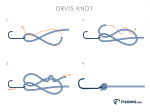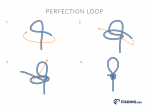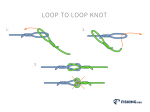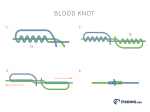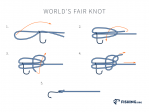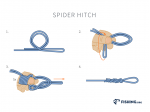Fishing knots can be distinguished by grouped categories such as terminal tackle connections, miscellaneous knots, line to line knots and loop knots. The miscellaneous knots are set apart because they are vastly different from the other categories. The fishing knots can also be categorized based on function i.e. saltwater knots, beginner knots, tenkara knots and fly fishing knots among others. The riffle hitch is a popular knot designed to allow the fly to skim on the river surface in order to attract feeding fish. The knot also stands out as one of the top fishing knot on the widely renowned, Pro-Knot Fly Fishing Knot Cards. The building instructions for tying the knot are fairly easy. You need to first tie the leader using a chosen or preferred knot, then move to the front of the leader and create a loop. Next, pass the loop above the fly and tighten down to make a half hitch right on the fly shank. Follow this step by creating another loop similar to the first one.
The second loop should pass over the fly, before it is tightened at the front of the half hitch created during the second step. Lastly, adjust the fly to allow the leader to exit the knot under the eye in a perpendicular direction to the hook shank. Remember, the knot is usually tied after the main knot linking the fly top leader is made. For most fishermen, the most preferred main matching knot is the Turle knot. This knot is normally placed past the eye of the hook. When fully tied, the line should come out under the eye to allow it to stand perpendicular to the hook shank. The riffle hitch knot is most often used by fisherman interested in catching different types of fish, chief among them steelhead, salmon and trout. The other similar knots include the Uni Knot, Knotless Knot, Orvis Knot and Improved Clinch. When you go out fishing, always pick an appropriate fishing knot and ensure it is tied properly. The knots should be well lubricated either with water or saliva before tightening.

 Joshua Keaton
Joshua Keaton 
